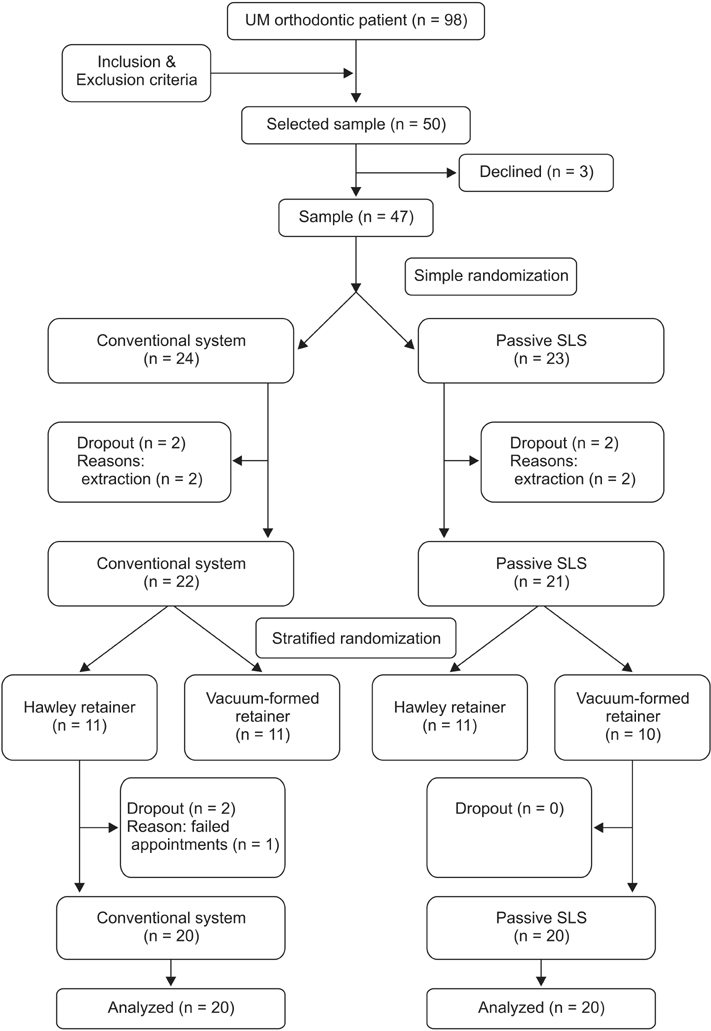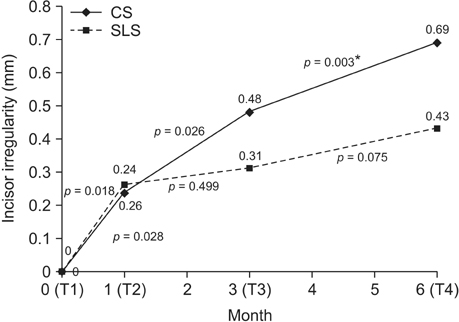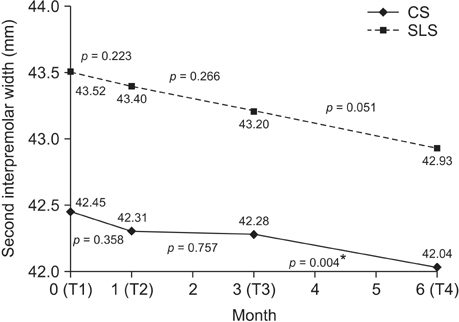Korean J Orthod.
2017 Jan;47(1):11-20. 10.4041/kjod.2017.47.1.11.
Mandibular arch orthodontic treatment stability using passive self-ligating and conventional systems in adults: A randomized controlled trial
- Affiliations
-
- 1Orthodontics Unit, School of Dental Sciences, Universiti Sains Malaysia, Kelantan, Malaysia. normaabrahman@gmail.com
- 2Department of Paediatric Dentistry and Orthodontics and Clinical Craniofacial Dentistry Research Group, Faculty of Dentistry, University of Malaya, Kuala Lumpur, Malaysia.
- KMID: 2392192
- DOI: http://doi.org/10.4041/kjod.2017.47.1.11
Abstract
OBJECTIVE
This randomized controlled trial aimed to compare the stability of mandibular arch orthodontic treatment outcomes between passive self-ligating and conventional systems during 6 months of retention.
METHODS
Fortyseven orthodontic patients with mild to moderate crowding malocclusions not requiring extraction were recruited based on inclusion criteria. Patients (mean age 21.58 ± 2.94 years) were randomized into two groups to receive either passive self-ligating (Damon® 3MX, n = 23) or conventional system (Gemini MBT, n = 24) orthodontic treatment. Direct measurements of the final sample comprising 20 study models per group were performed using a digital caliper at the debonding stage, and 1 month, 3 months, and 6 months after debonding. Paired t-test, independent t-test, and non-parametric test were used for statistical analysis.
RESULTS
A significant increase (p < 0.01) in incisor irregularity was observed in both self-ligating and conventional system groups. A significant reduction (p < 0.01) in second interpremolar width was observed in both groups. Mandibular arch length decreased significantly (p = 0.001) in the conventional system group but not in the self-ligating system group. A similar pattern of stability was observed for intercanine width, first interpremolar width, intermolar width, and arch depth throughout the 6-month retention period after debonding. Comparison of incisor irregularity and arch dimension changes between self-ligating system and conventional system groups during the 6 months were non-significant.
CONCLUSIONS
The stability of treatment outcomes for mild to moderate crowding malocclusions was similar between the self-ligating system and conventional system during the first 6 months of retention.
MeSH Terms
Figure
Reference
-
1. Freitas KM, de Freitas MR, Henriques JF, Pinzan A, Janson G. Postretention relapse of mandibular anterior crowding in patients treated without mandibular premolar extraction. Am J Orthod Dentofacial Orthop. 2004; 125:480–487.
Article2. Melrose C, Millett DT. Toward a perspective on orthodontic retention? Am J Orthod Dentofacial Orthop. 1998; 113:507–514.
Article3. Nanda RS, Nanda SK. Considerations of dentofacial growth in long-term retention and stability: is active retention needed? Am J Orthod Dentofacial Orthop. 1992; 101:297–302.
Article4. Destang DL, Kerr WJ. Maxillary retention: is longer better? Eur J Orthod. 2003; 25:65–69.
Article5. Shawesh M, Bhatti B, Usmani T, Mandall N. Hawley retainers full- or part-time? A randomized clinical trial. Eur J Orthod. 2010; 32:165–170.
Article6. Sheridan JJ, LeDoux W, McMinn R. Essix retainers: fabrication and supervision for permanent retention. J Clin Orthod. 1993; 27:37–45.7. Eliades T, Pandis N, Johnston LE, White LW. Selfligation in orthodontics. 1st ed. Wiley-Blackwell;2009.8. Damon DH. The rationale, evolution and clinical application of the self-ligating bracket. Clin Orthod Res. 1998; 1:52–61.
Article9. Khambay B, Millett D, McHugh S. Evaluation of methods of archwire ligation on frictional resistance. Eur J Orthod. 2004; 26:327–332.
Article10. Griffiths HS, Sherriff M, Ireland AJ. Resistance to sliding with 3 types of elastomeric modules. Am J Orthod Dentofacial Orthop. 2005; 127:670–675.
Article11. Henao SP, Kusy RP. Frictional evaluations of dental typodont models using four self-ligating designs and a conventional design. Angle Orthod. 2005; 75:75–85.12. Kim TK, Kim KD, Baek SH. Comparison of frictional forces during the initial leveling stage in various combinations of self-ligating brackets and archwires with a custom-designed typodont system. Am J Orthod Dentofacial Orthop. 2008; 133:187.e15–187.e24.
Article13. Franchi L, Baccetti T, Camporesi M, Lupoli M. Maxillary arch changes during leveling and aligning with fixed appliances and low-friction ligatures. Am J Orthod Dentofacial Orthop. 2006; 130:88–91.
Article14. Chen SS, Greenlee GM, Kim JE, Smith CL, Huang GJ. Systematic review of self ligating brackets. Am J Orthod Dentofacial Orthop. 2010; 137:726.e1–726.e18.15. Rowland H, Hichens L, Williams A, Hills D, Killingback N, Ewings P, et al. The effectiveness of Hawley and vacuum-formed retainers: a single-center randomized controlled trial. Am J Orthod Dentofacial Orthop. 2007; 132:730–737.
Article16. Thickett E, Power S. A randomized clinical trial of thermoplastic retainer wear. Eur J Orthod. 2010; 32:1–5.
Article17. Ab Rahman N, Low TF, Idris NS. A survey on retention practice among orthodontists in Malaysia. Korean J Orthod. 2016; 46:36–41.
Article18. Damon D, Bagden MA. Damon system: The workbook. Glendora, CA: Ormco Corporation;2004.
- Full Text Links
- Actions
-
Cited
- CITED
-
- Close
- Share
- Similar articles
-
- Randomized controlled clinical trial of oral health-related quality of life in patients wearing conventional and self-ligating brackets
- Modified Mandibular Lingual Arch for Orthodontic Traction of Impacted Mandibular Canine and Premolar: Case Reports
- A comparative study of frictional force in self-ligating brackets according to the bracket-archwire angulation, bracket material, and wire type
- Pain perception among patients treated with passive self-ligating fixed appliances and Invisalign® aligners during the first week of orthodontic treatment
- Mandibular changes during initial alignment with SmartClip self-ligating and conventional brackets: A single-center prospective randomized controlled clinical trial





